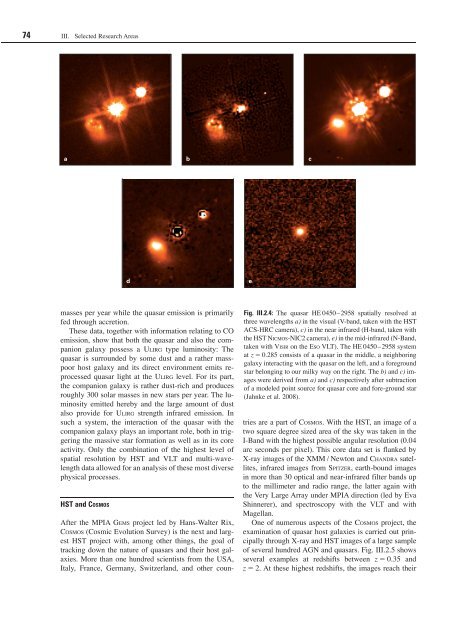Max Planck Institute for Astronomy - Annual Report 2007
Max Planck Institute for Astronomy - Annual Report 2007
Max Planck Institute for Astronomy - Annual Report 2007
You also want an ePaper? Increase the reach of your titles
YUMPU automatically turns print PDFs into web optimized ePapers that Google loves.
74 III. Selected Research Areas<br />
a b c<br />
masses per year while the quasar emission is primarily<br />
fed through accretion.<br />
These data, together with in<strong>for</strong>mation relating to CO<br />
emission, show that both the quasar and also the companion<br />
galaxy possess a ul i r g type luminosity: The<br />
quasar is surrounded by some dust and a rather masspoor<br />
host galaxy and its direct environment emits reprocessed<br />
quasar light at the ul i r g level. For its part,<br />
the companion galaxy is rather dust-rich and produces<br />
roughly 300 solar masses in new stars per year. The luminosity<br />
emitted hereby and the large amount of dust<br />
also provide <strong>for</strong> ul i r g strength infrared emission. In<br />
such a system, the interaction of the quasar with the<br />
companion galaxy plays an important role, both in triggering<br />
the massive star <strong>for</strong>mation as well as in its core<br />
activity. Only the combination of the highest level of<br />
spatial resolution by HST and VLT and multi-wavelength<br />
data allowed <strong>for</strong> an analysis of these most diverse<br />
physical processes.<br />
HST and CO S m O S<br />
d e<br />
After the MPIA ge m S project led by Hans-Walter Rix,<br />
co S m o S (Cosmic Evolution Survey) is the next and largest<br />
HST project with, among other things, the goal of<br />
tracking down the nature of quasars and their host galaxies.<br />
More than one hundred scientists from the USA,<br />
Italy, France, Germany, Switzerland, and other coun-<br />
Fig. III.2.4: The quasar HE 0450–2958 spatially resolved at<br />
three wavelengths a) in the visual (V-band, taken with the HST<br />
ACS-HRC camera), c) in the near infrared (H-band, taken with<br />
the HST ni c m o S-NIC2 camera), e) in the mid-infrared (N-Band,<br />
taken with viSir on the eSo VLT). The HE 0450–2958 system<br />
at z 0.285 consists of a quasar in the middle, a neighboring<br />
galaxy interacting with the quasar on the left, and a <strong>for</strong>eground<br />
star belonging to our milky way on the right. The b) and c) images<br />
were derived from a) and c) respectively after subtraction<br />
of a modeled point source <strong>for</strong> quasar core and <strong>for</strong>e-ground star<br />
(Jahnke et al. 2008).<br />
tries are a part of co S m o S. With the HST, an image of a<br />
two square degree sized area of the sky was taken in the<br />
I-Band with the highest possible angular resolution (0.04<br />
arc seconds per pixel). This core data set is flanked by<br />
X-ray images of the XMM / Newton and ch a n d r a satellites,<br />
infrared images from Sp i t z e r, earth-bound images<br />
in more than 30 optical and near-infrared filter bands up<br />
to the millimeter and radio range, the latter again with<br />
the Very Large Array under MPIA direction (led by Eva<br />
Shinnerer), and spectroscopy with the VLT and with<br />
Magellan.<br />
One of numerous aspects of the co S m o S project, the<br />
examination of quasar host galaxies is carried out principally<br />
through X-ray and HST images of a large sample<br />
of several hundred AGN and quasars. Fig. III.2.5 shows<br />
several examples at redshifts between z 0.35 and<br />
z 2. At these highest redshifts, the images reach their

















